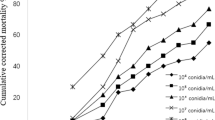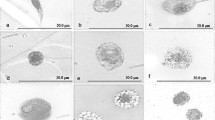Abstract
The insect-parasitic rhabditoid nematodes,Steinernema feltiae andHeterorhabditis bacteriophora, released a compound/s/ toxic to larvae of the greater wax moth,Galleria mellonella, that caused paralysis and death of the insect. Larvicidal substances appeared in wax moth larvae during parasitism and after inoculation with the primary form of the bacterial associates of the nematodes. The nematodeS. feltiae and its associate,Xenorhabdus nematophilus, excreted much less toxic activity within larval body thanH. bacteriophora. The secondary form ofXenohabdus did not produce toxin in parasitized larvae, butX. luminescens, the bacterium associated withH. bacteriophora, released detectable titer of toxin activity in broth cultures. Both nematode toxins were sensitive to heat and produced a specific type of proteolytic activity. Preliminary identification of the compounds responsible for larval toxicity revealed similarities to immune inhibitors produced by some bacterial pathogens of insects.
Résumé
Les nématodes rhabditoïdes parasites d'insectes,Steinernema feltiae etHeterorhabditis bacteriophora libèrent un composé (s) toxique pour les larves de la Teigne,Galleria mellonella, qui provoque la paralysie et la mort de l'insecte. Les substances larvicides apparaissent dans les larves de teigne durant le parasitisme et après inoculation avec la forme primaire des bactéries associées aux nématodes. Le nématodeS. feltiae et son associé,Xenorhabdus nematophilus excrètent beaucoup moins d'activité toxique à l'intérieur du corps de la larve queH. bacteriophora. La forme secondaire deXenorhabdus ne produisait pas de toxine chez la larve parasitée, maisX. luminescens, bactérie associée àH. bacteriophora, libérait un titre détectable d'activité toxique dans les milieux liquides. Les deux toxines de nématode étaient sensibles à la chaleur et produisaient un type spécifique d'activité protéolytique. L'indentification préliminaire des composés responsables de la toxicité larvaire révélait des similitudes avec les inhibiteurs d'immunité produits par quelques bactéries pathogènes d'insectes.
Similar content being viewed by others
References
Akhurst, R. J. — 1980. Morphological and functional dimorphism inXenorhabdus spp., bacteria symbiotically associated with the insect pathogenic nematodesNeoplectana andHeterorhabditis. —J. gen. Microb., 121, 303–309.
— — 1982. AXenorhabdus sp. [Eubacteriales: Enterobacteriaceae] symbiotically associated withSteinernema kraussei [Nematoda, Steinernematidae]. —Rev. Nematol., 5, 277–280.
— — 1983. Taxonomic study ofXenorhabdus, a genus of bacteria symbiotically associated with insect pathogenic nematodes. —Int. J. Syst. Bact., 33, 38–45.
Bedding, R. A. &Akhurst, R. J. — 1975. A simple technique for the detection of insect parasitic rhabditid nematodes in soil. —Nematologica, 27, 109–110.
Bedding, R. A. — 1981. Low cost in vitro mass production ofNeoaplectana andheterorhabditis species [Nematoda] for field control of insect pests. —Nematologica, 27, 109–114.
Boemare, N., Laumond, C. &Luciani, J. — 1982. Mise en évidence d'une toxicogenèse provoquée par le nématode axéniqueGalleria mellonella L. —C. R. Acad. Sc. Paris, 295, 543–546.
Boman, H. G. — 1982. Humoral immunity and the counter defence of some pathogens. —Fortsch. Zool., vol. 27,Zbl. Bact. Suppl., 12; Immune Responses to Parasites. —Gustav Fischer Verlag., Stuttgart — New York.
Burman, M. — 1982.Neoplectana carpocapsae: Toxin production by axenic insect parasitic nematodes. —Nematologica, 28, 62–70.
Dalhammar, G. &Steiner, H. — 1984. Characterization of inhibitor A, a protease fromBacillus thuringiensis which degrades attacins and cecropins, two classes of antibacterial proteins in insects. —Eur. J. Biochem., 139, 247–252.
Finney, J. R. &Bennett, G. F. — 1983. The susceptibility of some sawflies [Hymenoptera: Tenthredinidae] toHeterorhabditis heliothidis [Nematoda: Heterorhabditidae] under laboratory conditions. —Can. J. Zool., 61, 1177–1180.
—— — 1984.Heterorhabditis heliothidis: A potential biocontrol agent of agricultural and forest pests in Newfoundland. —J. Agric. Entomol., 1, 281–295.
Götz, P., Boman, A. &Boman, H. G. — 1981. Interactions between insect immunity and an insect-pathogenic nematode with symbiotic bacteria. —Proc. R. Soc. London, B 212, 333–350.
Kaya, H. K. &Hara, A. H. — 1980. Differential susceptibility of lepidopterous pupae to infection by the nematodeNeoaplectana carpocapsae. —J. Invertebr. Pathol., 36, 389–393.
Milstead, J. E. — 1979.Heterorhabditis bacteriophora as a vector for introducing its associated bacterium into the hemocoel ofGalleria mellonella larvae. —J. Invertebr. Pathol., 33, 324–327.
— — 1980. Pathophysiological influences of theHeterorhabditis bacteriophora complex on seventhinstar larvae ofGalleria mellonella: Effect of silk production. —J. Invertebr. Pathol., 35, 256–259.
Morris, O. N. — 1985. Susceptibility of 31 species of agricultural insect pests to the entomogenous nematodesSteinernema feltiae andHeterorhabditis bacteriophora. —Can. Entomol., 117, 401–407.
Poinar, G. O. — 1966. The presence ofAchromobacter nematophilus in the infective stage of aNeoaplectana sp. [Steinernematidae: Nematoda]. —Nematologica, 12, 105–108.
Poinar, G. O. Jr. — 1979. Nematodes for Biological Control of Insects. —CRC Press, Boca Raton, Florida.
Poinar, G. O. Jr. &Gyrisco, G. G. — 1962. Studies on the binomics ofHexamermis arvalis Poinar and Gyrisco, a mermithid parasite of the alfalfa weevil,Hypera postica Gyllenhal). —J. Insect Pathol., 4, 469–483.
Poinar, G. O. Jr. &Thomas, G. M. — 1966. Significance ofAchromobacter nematophilus Poinar and Thomas [Achromobacteriaceae: Eubacteriales] in the development of the nematode, DD136 [Neoaplectana sp.,Steinernematidae]. —Parasitology, 56, 385–390.
Poinar, G. O. Jr. &Himsworth, P. T. — 1967.Neoaplectana parasitism of larvae of the greater wax moth,Galleria mellonella. —J. Invertebrate Pathol., 9, 241–246.
Poinar, G. O. Jr., Thomas, G. M. &Hess, H. — 1977. Characteristic of the specific bacterium associated withHeterorhabditis bacteriophora [Heterorhabditidae: Rhabditida]. —Nematologica, 23, 97–102.
Poinar, G. O. Jr. &Thomas, G. M. — 1978. Diagnostic Manual for the Identification of Insect Pathogens. —Plenum Press, New York.
Poinar, G. O. Jr., Evans, J. S. &Schuster, E. — 1983. Field test of the entomogenous nematode,Neoaplectana carpocapsae, for control of corn rootworm larvae [Diabrotica sp.:Coleoptera]. —Protection Ecol., 5, 337–342.
Sandner, H. &Stanuszek, S. — 1971. Comparative research on the effectiveness and production ofNeoaplectana carpocapsae. —Zesz. Probl. Post. Nauk Roln., 121, 209–226.
Schmiege, D. C. — 1963. The feasibility of using a neoaplectanid nematode for control of some forest insect pests. —J. Econ. Entomol., 56, 427–431.
Sidén, I., Dalhammar, G., Telander, B., Boman, H. G. &Somerville, H. —1979. Virulence factor inBacillus thuringiensis: Purification and properties of a protein inhibitor of immunity in insects. —J. gen. Microb., 114, 45–52.
Tanaka, S. — 1972. Effect of a new microsporidiosis of the silkworm,Bombyx mori, on the cocoon weight, the cocoon shell weight and the number of eggs laid. —J. Sericult. Sci., Japan, 41, 305–308.
Thomas, G. M. &Poinar, G. O. Jr. — 1979.Xenorhabdus gen. nov., a genus of entopathogenic nematophilic bacteria of the familyEubacteriales. —Int. J. Syst. Bact., 29, 352–360.
Triggiani, O. &Poinar, G. O. Jr. — 1976. Infection of adult Lepidoptera byNeoaplectana carpocapsae [Nematoda]. —J. Invertebr. Pathol., 27, 413–414.
Author information
Authors and Affiliations
Rights and permissions
About this article
Cite this article
Jarosz, J., Balcerzak, M. & Skrzypek, H. Involvement of larvicidal toxins in pathogenesis of insect parasitism with the rhabditoid nematodes,Steinernema feltiae andHeterorhabditis bacteriophora . Entomophaga 36, 361–368 (1991). https://doi.org/10.1007/BF02377940
Received:
Accepted:
Issue Date:
DOI: https://doi.org/10.1007/BF02377940




